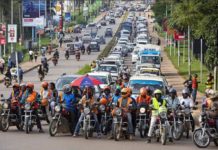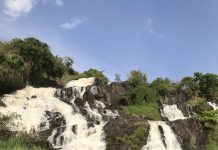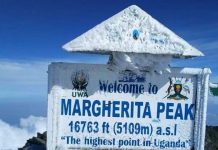A chilly Monday is when we departed for the trip to the land of lions south west of Kampala travelling to the western region of Uganda the pearl of Africa. The journey started off from Mengo at Muteesa 1 royal university early in the morning and travelled by the university bus. We took Hoima road through mubende, fort portal, Kasese route to the park in Rukungiri district. It was a long trip full of fun, entertainment and memories throughout. A break in the journey was in fort portal town for lunch, detoured around the urban settings of the city and the toro kingdom palace of the Omukama were the cultural monuments are found. We proceeded with the journey to Kasese passing by various greeneries, plantations, farmlands, thatched houses among others.
We took a glimpse of the magnificent Rwenzori ranges which is known as the fabled mountains of the moon a block mountain, snow capped at its peak called the Margherita .Rwenzori is ranked as the highest equatorial snow peaked point in Africa with many Nile sources . It is shared by both Uganda and Congo comprising of different vegetation zones such as the moorland, Bamboo and the rich moist montane forest. From a mile away you can observe the misty ranges surrounded with enchanting flowers creating a fairytale scenery, colorful mosses and huge tree heathers. We descended to Queen Elizabeth national park Uganda’s most visited park located in Rukungiri town known for its tree climbing lions occupying an estimation of 1978 square kilometers. It extends to Lake Edward and Lake George being bisected by the Kazinga channel. It was gazatted as a national park in 1952 from Kazinga national park after a commemoration of the queen of England to Queen Elizabeth national park. The south of the park harbors one of the big five mammals, the tree climbing lions in the Ishasha sector.
Queen Elizabeth national park together with the Virunga Mountains is a lion conservation unit. They are both potential strong holds of lions in central Africa consisting of thick dry vegetation type and fig tree branches. It is also known for its volcanic features including the volcanic cones and craters for example Lake Katwe crater where salt in Uganda is extracted. In the evening we reached katungulu gate and went straight to the park’s dormitories. It was a long exhausting journey mere reaching we opted for refreshment, relaxation and prepared for a night sleep getting rid of the accumulated fatigue. The following early morning after a consuming a tantalizing cup of fresh coffee aroma, we went for a morning game drive at the kasenyi sector mating grounds for herds of antelope such as the Uganda kob and other wildlife species like warthogs. The plain comprises of endless view of roaming antelopes in the savannah plains. The lions and other cats are frequent visitors of the plain since the plains harbors many antelopes which are prominent prey around the park. The plains give a clear view to the predators seeing their prey from a distance. The kasenyi plains is a homes to many wildlife species mostly the cats like lions and leopards , antelopes and birds observed while at a game drive.
The plains are adjacent neighbors to Lake George and give a stunning view of the nearby lakes and lions amounting to 200 in number in the breeding area. Lake George has long papyrus swamp harboring animals that you cannot see anywhere in the lake such animals include water buck, sitatungas and antelopes. While at the plains, we spotted numerous common bird species such as grey crown cranes, red- throat spur fowl, yellow throated long crow among others. You will see the Kazinga channel where it requires a 2 hours boat cruise ride in the afternoon hours to come closer to hippos and crocodiles at the same time spot elephants from the mighty Kazinga plains playing and bathing in water. The kasenyi plains is an adjacent area suitable for photography as it gives a clear shot of the lion feasting on its prey providing a memorable experience of life in Africa’s wilderness.
We saw other attractions in Kazinga channel such as the kasenyi airport which provides fastest means at the same time an attraction, the Kazinga channel located south west of the kasenyi plains, lakes such as Lake Bunyampaka and lake George with long papyrus swamps harboring creatures like waterbucks, sitatungas, antelopes. We went to kasenyi fishing village where we got served with fresh fish snacks. We also saw different islands and with the help of the tour guide he mentioned to us their names which were Kankurango, Irangara, Akika and the Epic community of the Kasoga’s.
In the afternoon we went to Kazinga channel for a boat cruise and here we experienced the sea breeze and an amazing launch trip ever. The stress and fatigue got accumulated away as we inhaled in the fresh sea air. While boarding at the cruise, we meet up with professional tour guide who provided us with the necessary required information were Kazinga channel is a long fresh natural channel connecting the two lakes in Uganda which is Lake George and Lake Edward. The boat drifted slowly descending through the channel going deep giving a clear view of nature and wildlife. This provided us a great opportunity to take clear photos for memorable sea experience. We spotted vast number of wildlife species such as a herd of Buffalo, elephants and the lonely buffaloes being kicked out from the herds. These lonely buffaloes are believed to have grown old stinking a lot and can no longer travel for long distances. The Buffaloes keep themselves within the water for protection and also keeping away from predators.
Kazinga channel is believed to having a high concentration of Hippopotamus in the whole of Africa. Hippos don’t swim but just bounce in the water as a way of movement and they resurface for 3-5 minutes for survival. They are terrestrial and secrete a reddish oily cream which gives people think they sweat blood and have a sensitive skin. We got exposed to other aquatic animals like the crocodiles and other wildlife that come to the banks in the evening for a bath and quench their thirst such as the elephants, Ugandan kob, water bucks, buffaloes and other nocturnal creatures.
The kazinga channel provides a nice array of beautiful birds providing a great opportunity to bird lovers. These birds soar near the water surface and the common species include the African spoonbill, cormorants, pelicans, martial eagles, African skimmers among others. It’s very hard to pin down a shoe bill stork. We had a great time at the launch cruise and returned to the dormitories for a night sleep.
On the third day of the queen Elizabeth national park trip, we prepared for birding early in the morning as we marveled at the spectacular bird species. Uganda is believed to be the famous birding destination in the whole of Africa consisting of a variety of birds found in different national parks and all around. We encountered a number of 550 bird species that made our trip charming and gave a great experience to most of the bird lovers. Queen Elizabeth consists of a diversity of forests such as the riverine bush-land, moist thickets, and riparian forests inhabit many bird species. The variety of bird species we spotted included the prominent species such as Verreaux’s eagle-owl, grey headed king fisher, papyrus gonolek, other species we happened not to see included papyrus canary, African skimmer, white winged terns, thin-tailed nightjar among others. We also sighted some aquatic bird species like the fish eagle, squacco Heron, African jacana, the black crake, long tailed cormorants, pied king fisher among others.
We went to the maramagambo forest where we sighted other bird species such as the charming white spotted fluff tail in the thickets by the river side. We spotted different primates and other wildlife species roaming in the forests such vervet monkeys, grey cheecked mangabey, white and black colubus, some indigenous plant and tree species and small insects.
In the afternoon, we travelled to Lake Katwe a salt water lake and Uganda’s salt gardens located north of Mweya peninsular. We mingled and mixed with the locals who do the extraction activity. Lake Katwe is famous for salt production and is found in the south western part inside Queen Elizabeth in Kasese district. Salt miners demarcate owned plots with salt spans to prevent intensity evaporation. Different types of salt are extracted for example the rock salts commonly as sodium chloride used as table salts, mud salt particles known as lick salt used in cattle production. The salt miners wear plastic bags and condoms for the case of men and women apply flour in their vaginas to protect their private parts from being damaged by the saline water. Salt is transported using the ambutch trees from areas of extraction to the margin span. We observed the different processes of salt extraction and how the locals carry the mined salt licks on their ambutch trees to the surface. Different salt licks were compiled and others packed in sacks as others were being transported to the refinery companies for processing into table salts. We went ahead to interact with the local people on how to safe guard themselves from the dangers incurring from salt extraction. The locals love their jobs and invest a lot of efforts and passion while extraction, the benefits gained are shared and this has improved their standards of living were the young ones attain education, better house constructed, roads reconstructed and other services improved. Near the salt plots is a market where locals do trade among fellow locals and sell things to tourists like drinks and snacks.
We later travelled to the Kyambura gorge to meet up with the tour guide. We sat at the gorge centre constructed with bricks and thatched with dry grass at the top. This gives a clear view of the tropical thick green vegetation and sound of the roaring water from the river which crosses the gorge. The guide provided us with the required information of the gorge were by the kyambura derives its name from a story were the river floored carrying away the locals with their properties. When the speed of water reduced, the locals followed back the river towards their one homesteads looking for their fellow locals but all in vain. They came back saying “kyambura” meaning they lost them hence the name. The best activity done in the Kyambura gorge is chimpanzee tracking sometimes referred to as the Kyambura walk which requires one to cross the gorge on natural wooden bridges catching up with the scampering chimps. It is on a rare basis that you will see the chimpanzee as they swing from down to the top on tree branches. They can only be tracked from the sound they make while in the tree branches and this gives an opportunity to trackers to follow the track of the sound. During the walk, different primates and other species are encountered such as vervet monkeys, red tailed monkeys, black and white colubus and bird species such as the white kingfisher, bee eaters and cormorant among others.
We went south of the park to the Ishasha sector, the land of the lions. It’s very rare to see climbing lions but in Uganda their only seen in queen Elizabeth national park. We searched for the lions in the southern wilderness and by luck we say one resting in the tree branch. After a long drive, we went to the Ishasha rest camp in the evening hours with our camping gears for a night. While at the camp, we saw two rivers separating Uganda and DR. Congo inhabiting a pod of Hippopotamus. The Congolese hunt the hippopotamus selling off their meat to the local market but strategies were put to minimize the illegal poaching of the Hippos. The night was so cold as we left the bond fire in the late night for a sleep in our tents but faced a disturbance from the roaring Hippos. We were awakened by the early morning singing birds and travelled back to our first destination of the journey. This was a memorable trip as we encountered the bestselling product the lions and the second which are the Chimpanzees.





